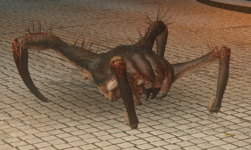registry: brush him
Active member
- Joined
- Jun 11, 2020
- Messages
- 126
- Thread Author
- #1
Introduction
---------------------------------------------------------
When the species of Xen rampaged across Earth in the interval of infestation and the intensifying portal storms, among the several invasive species recorded were the Headcrabs.---------------------------------------------------------
These were made known to the Black Mesa Science Team when they began research on Xen. These parasitics would latch onto the heads of their hosts, use their beaks to latch onto their parietal lobes, and forebeaks to paralyze the victim so that they would be forced into submission.
However, a few years after the Combine conquered the world now known as Planet 314 during the Seven Hour War, the simple white-bodied, chicken-like headcrab began to show several subspecies, usually deployed during infection shellings. These subspecies were likely a result of genetic engineering by the Combine, breeding them to be more dangerous and useful.
Among them were the Venomous Headcrabs, taxonomically designated as the "Xenoparasitus Venunum" (Poisonous Alien Parasite), and also known simply as "Poison Headcrabs", or "Venom Viromes" in Combine Phaseology.
Survival and Parasitism
---------------------------------------------------------
Displaying a level of intelligence roughly twice that of a standard parasitic (and 2.5x the weight) Venomous Headcrabs have a survival instinct that revolves around clever hunting tactics. While most headcrabs very deliberately attempt to couple with human hosts, the poisonous variant is known to only seek sustenance, preying upon small animals and attacking humans with the intent of poisoning or even paralyzing them so that they might be weakened and killed later.---------------------------------------------------------
When threatened, these Venomous Headcrabs are known to slowly drum their legs against the ground, creating a slow, pounding noise. If threats continue to approach, or if they are simply hunting, they will pounce prey directly.
A pounce can easily be identified by a sound emanated by the headcrab prior to its pounce, sounding akin to a "rattle" or "hiss", or a mixture of both. This is the sound of a "tongue" within the crab twitching and shaking rapidly, as well as the beaks and mandibles of the crab rattling vibrantly, along with the creature vocalizing a hiss. It is an unmistakable sign that the creature is about to jump towards prey it is facing.
One weakness this variant has is its inability to properly hold a host. While Poison Headcrabs have the adrenaline compounds needed to maneuver unwilling hosts, they lack the proper paralytic needed to restrain the victim until coupling can be achieved (theoretically due to their poison glands mostly replacing paralytic glands). For this reason, to claim a host, it is necessary for the headcrabs to infect victims with their neurotoxin, and then stalk them until they succumb to its primary symptom: Fatigue.
When the host has been claimed, other hitchhikers may participate, leaping onto any other part of the human host as long as they provide the proper adrenaline to keep it moving. At this point, as long as the primary headcrab is attached, the necrotic may continue.
Poison Necrotics are hulking, bloated, overgrown zombies with incredible weight and at least three attached headcrabs. They do not typically last long in the wild - their bodies are constantly secreting fluid and being harvested by the headcrabs, which eventually decomposes the host and leaves it entirely unusable.
True to their name, they are not venomous - but they ARE poisonous. Contact with them has been known to expose humans to several forms of viral diseases, and tends to cause often debilitating illnesses.
One specific disease caused by contact with Poison Necrotics is "Sub-Necrosis". Sub-Necrosis is a very specific form of Necrosis that kills cells on a very small scale at first, but left unwashed or untreated (especially in cases where the victim is immuno-compromised), it can spread and cause limbs to become gangrenous as the Sub-Necrosis becomes fully Necrotic.
Neurotoxin Symptoms & Treatment
---------------------------------------------------------
Venom Virome Neurotoxin is inflicted in sporadic cases of Sub-Necrosis caused by contact with a Poison Necrotic, or laceration from a Venomous Headcrab. Its effects are easily identified.---------------------------------------------------------
-High Fatigue
-Nausea & Vomiting
-Weakness
-Asphyxiation
-Sub-Necrosis
-Paralyzing
-Cardiac Arrest
-Organ Failure
Recovery from the poison is possible and happens in most cases where the victim is healthy and their immune system is capable of removing the Sub-Necrotic compounds. If a neurotoxin antidote is administered, all effects can be removed in as little as an hour. Symptoms will worsen with repeated exposure, and it is recommended to treat the lacerated area as soon as possible so as to prevent infection, which would almost certainly be crippling or lethal.
After an antidote has been administered or the immune system has ridded the neurotoxin, antibiotics or surgery will be necessary to remove the long-term effects of Sub-Necrosis, if that is a symptom of the neurotoxin (which is somewhat rare).
Venomous Headcrab neurotoxin is not always lethal on its own due to the circumstances of administration - it is not regularly administered in a high enough volume to be fatal to a human with a strong immune system. If a victim's vitals are in optimal condition, they are far less likely to be killed by the neurotoxin.
Due to the variances in the toxin's effects, great care should always be taken of the wound where possible if a laceration is received from a Venomous Headcrab. This is to prevent infection and belay the spread of any extreme symptoms such as sub-necrosis.
Last edited:
